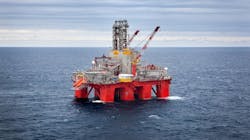Statoil proves oil updip of North Sea Verbier structure
Offshore staff
STAVANGER, Norway -- Statoil and its partners have discovered oil with a side track well on the Verbier prospect in the UK central North Sea.
The semisubmersible Transocean Spitsbergen drilled the side track well after the main wellbore encountered water-filled sand. Rather than abandon the operation, the partners opted for a side track to assess the remaining potential updip.
Preliminary analysis suggests a minimum of 25 MMbbl of recoverable oil close to the wellbore, with potential for up to 130 MMbbl.
Jez Averty, Statoil’s svp exploration in Norway and the UK, said the well had proven oil in good-quality sands with good reservoir properties, but that appraisal drilling and other work would likely be needed to clarify the recoverable volumes and to refine this range.
In addition, the partners will seek to determine the commerciality of the discovery and to mature further drilling opportunities within the P2170 license, located in the Outer Moray Firth offshore northeast Scotland.
“The results show that we made the right decision to side track the well and this discovery proves that there could be significant remaining potential in this mature basin,” said Jenny Morris, vp for exploration in the UK.
Statoil drilled two other exploration wells in the area this summer. The Mariner Segment 9 well encountered two oil-filled sands in the Heimdal formation and a thin oil column in the deeper Maureen formation, and the acquired data should help establish the extent of the Heimdal sand bodies, the impact on resources, and the future drainage strategy for the main Mariner field.
The Jock Scott well, however, was dry.
10/09/2017
